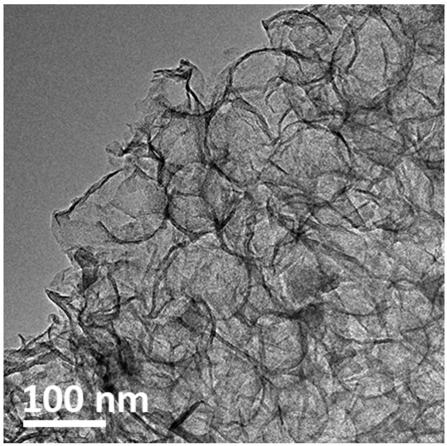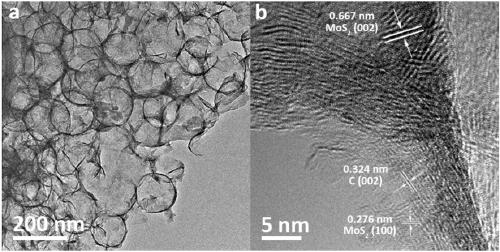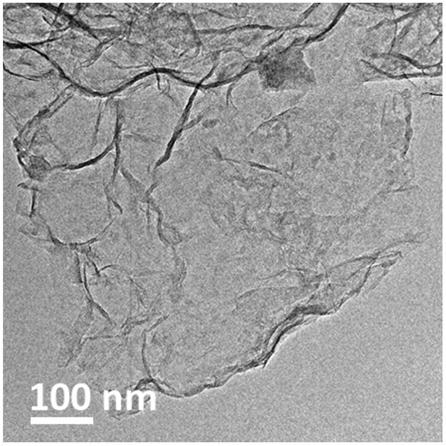Preparation method of heteroatom doped porous molybdenum disulfide coated graphene
A technology of molybdenum disulfide and graphene, which is applied in the direction of chemical instruments and methods, chemical/physical processes, physical/chemical process catalysts, etc., to achieve the effect of facilitating the application of the method, wide application range, and good conductivity
- Summary
- Abstract
- Description
- Claims
- Application Information
AI Technical Summary
Problems solved by technology
Method used
Image
Examples
Embodiment 1
[0046] 1. Disperse 400mg of silica spheres in 200mL of ethanol, then reflux with 4mL of (3-aminopropyl)trimethoxysilane at 180°C for 5 hours, then add 0.8% graphene oxide water dispersion 3.7 g, stirred.
[0047] 2. Mix the sample obtained in (1) with 33 mg of ammonium molybdate, and dry at 80° C. for 5 hours.
[0048] 3. The sample obtained in (2) was transferred with 10 mL of carbon disulfide and sealed in a 60 mL autoclave in an argon atmosphere.
[0049] 4. React the autoclave in (3) at 400° C. for 9 hours.
[0050] 5. Treat the sample obtained in (4) with a 5% hydrofluoric acid solution by mass fraction for 8 hours, then wash with water, suction filter, and dry at 80° C. for 8 hours.
[0051] TEM (see figure 1 ) shows that the obtained sample has regular and uniform sponge-like three-dimensional channels, and the molybdenum disulfide single hole is evenly wrapped on the outer wall of the graphene single hole. X-ray diffraction spectrum (see Figure 4 Middle a) shows ...
Embodiment 2
[0053] 1. Disperse 400mg of silica spheres in 200mL of ethanol, then reflux with 4mL of (3-aminopropyl)trimethoxysilane at 180°C for 5 hours, then add 0.8% graphene oxide water dispersion 3.7 g, stirred.
[0054] 2. Mix the sample obtained in (1) with 33 mg of ammonium molybdate and 24 mg of cobalt nitrate, and dry at 80° C. for 5 hours.
[0055] 3. The sample obtained in (2) was transferred with 10 mL of carbon disulfide and sealed in a 60 mL autoclave in an argon atmosphere.
[0056] 4. React the autoclave in (3) at 400° C. for 9 hours.
[0057] 5. Treat the sample obtained in (4) with a 5% hydrofluoric acid solution by mass fraction for 8 hours, then wash with water, suction filter, and dry at 80° C. for 8 hours.
[0058] TEM (see figure 2 a) shows that the obtained sample has regular and uniform three-dimensional pores, and the high-resolution transmission electron microscope picture (see figure 2 b) It shows that the molybdenum disulfide single hole is evenly wrappe...
Embodiment 3
[0060] 1. Disperse 400mg of silica spheres in 200mL of ethanol, then reflux with 4mL of (3-aminopropyl)trimethoxysilane at 180°C for 5 hours, then add 0.8% graphene oxide water dispersion 3.7 g, stirred.
[0061] 2. Mix the sample obtained in (1) with 33 mg of ammonium molybdate and 12 mg of cobalt nitrate, and dry at 80° C. for 5 hours.
[0062] 3. The sample obtained in (2) was transferred with 10 mL of carbon disulfide and sealed in a 60 mL autoclave in an argon atmosphere.
[0063] 4. React the autoclave in (3) at 400° C. for 9 hours.
[0064] 5. Treat the sample obtained in (4) with a 5% hydrofluoric acid solution by mass fraction for 8 hours, then wash with water, suction filter, and dry at 80° C. for 8 hours.
[0065] Transmission electron microscopy showed that the obtained sample had regular and uniform three-dimensional pores, and no metal particles were found. The X-ray diffraction spectrum shows that the obtained sample is composed of molybdenum disulfide and gr...
PUM
| Property | Measurement | Unit |
|---|---|---|
| pore size | aaaaa | aaaaa |
| diameter | aaaaa | aaaaa |
Abstract
Description
Claims
Application Information
 Login to View More
Login to View More - R&D
- Intellectual Property
- Life Sciences
- Materials
- Tech Scout
- Unparalleled Data Quality
- Higher Quality Content
- 60% Fewer Hallucinations
Browse by: Latest US Patents, China's latest patents, Technical Efficacy Thesaurus, Application Domain, Technology Topic, Popular Technical Reports.
© 2025 PatSnap. All rights reserved.Legal|Privacy policy|Modern Slavery Act Transparency Statement|Sitemap|About US| Contact US: help@patsnap.com



